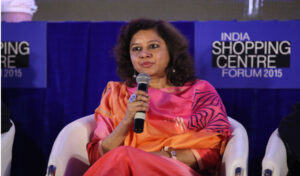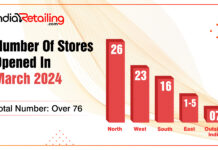Even as majority of the brick-and-mortar retailers in India have already dived into the lucrative, but challenging, world of e-commerce – either via a tie-up with an online peer or launching their own Omnichannel play – the debate is still on…
Who will win the game in the Indian retail landscape.
In order to know what consumers feel, we asked a simple question — Can Online and Offline retail exist together in India, without hurting each other’s profit?
A majority of respondents (90 per cent) agreed that both online and offline retail are heading toward a future where they will exist without any conflict of interest. Even industry experts echo this sentiment unanimously. Read on to know what the retail leaders have to say about the future of the world’s fastest growing major market.
1KRISH IYER, PRESIDENT and CEO WALMART INDIA
India continues to offer a market with tremendous potential. In the past couple of years, the economy seems to have stabilized with solid economic reforms and ‘ease of doing business’. Even if we were to dwell upon the primary factors, we would realise that India is scheduled for a massive boom in the retail sector – both brick-and-mortar and e-commerce.
Connectivity is improving dramatically across the landscape with several 4G launches and growth in smartphone market. People’s disposable income is growing in the country. The number of players in the market has increased manifold, thus giving more options and choices to the consumers. GST, when implemented, would prove to be a major leap forward.
So as I mentioned above, this is an exciting time for the retail industry and the next five years will belong to those who commit to provide the seamless Omnichannel experience to customers.e-Retail is undeniably a very big change and is here to stay.
Understandably, that is where the consumer is going in addition to shopping in stores. The choice, and ease of ordering from your smartphone gives a greater shopping convenience to the consumer, which in my opinion, would only grow in the coming years. Indian Retail – both brick-and-mortar and online, thus will continue to drive domestic consumption growth which in turn will boost manufacturing.
2MOHIT KHATTAR, HEAD – RETAIL STRATEGY AND BRANDING, GODREJ INDUSTRIES LIMITED
The overall e-commerce market that was about US $11 billion in 2015 is expected to grow at a CAGR of 45-50 per cent annually over the next couple of years. Growth in sectors like food and grocery is expected to outpace the growth in the brick-and-mortar retail space by up to seven times.
With increasing adoption of the smartphone, growing Internet penetration and a very large young population, e-commerce across sectors presents a humungous and mouthwatering opportunity for all players – including Amazon and Alibaba.
However, to succeed, players would need to be focused on core fundamentals – like understanding consumer insights around categories, understanding buying behavior, executing well and building long term value through fine-tuned processes, teams and a robust organization in general. Focus on GMV or discounts to build topline will neither build customer loyalty nor long term sustainable value.
3VINEET GAUTAM, COUNTRY MANAGER, BESTSELLER INDIA
The Indian market promises excellent growth opportunities considering we are home to the world’s largest youth population. The online space has created an exciting channel for brands as an additional way of selling.
Currently, the online business in India is all about capturing market share by increasing sales via discounts, which is justified to an extent since operating cost is lower compared to the brick-and-mortar format. But sales, solely driven by promos and markdowns don’t form a sustainable business in the long run. Competing on price only ensures commoditization of products.
As the e-commerce sector matures, companies will start competing for profit share instead of market share. Service innovation based on customer insight will be critical for sustainable e-commerce business. Logistics, IT and telecom infrastructure need to be upgraded to strengthen the back end.In India, growth possibilities for e-commerce companies are ample, but executing those possibilities by offering value to consumers will be critical for a sustained business model.
4VISHAL MALIK, DGM, RETAIL, INTEX TECHNOLOGIES
As we all know, India is rapidly growing and consumer demand has been on the rise steadily. This has attracted numerous MNCs as well as Chinese players to the market. Our retail strategy has always been to stay close to the consumer so as to make it convenient for them to experience our brand and make informed purchases.
Retail is a vast industry and there is ample room for success for everyone who can control costs and improve upon process efficiencies, something that we have been doing successfully.
5PUSHPA BECTOR, EXECUTIVE VP & HEAD DLF MALL OF INDIA
India’s e-commerce still has a long way to go when compared to other developed e-commerce markets like the US, UK, Germany and Canada. It was just a matter of time before the likes of Alibaba and Amazon entered the Indian market considering India has the second largest population that has vast retail opportunities in both B2C and B2B e-commerce segment.
We will see a lot of consolidation in the e-commerce segment, companies operating in service segment will witness a lot of M&A activity. Companies that operate in product-led space are working on altering their business model to monetize and attract investors from India and Abroad. Overall, we will see a lot more action and innovation in the e-commerce space in future.
6SUCHI MUKHERJEE, FOUNDER & CEO, LIMEROAD
There are three forces driving the interest in the Indian lifestyle/fashion space, despite the funding environment:
1) Clear global learnings: Globally Vipshop and Amazon’s 10-year journey in global fashion with less than spectacular success has proven that there is a role for a clear vertical lifestyle player, even in markets cluttered with price competitive horizontals.
2) Large demand and supply side: On the demand side, the retail lifestyle business in India is estimated at $70 billion of which only 1-2 per cent is online (in more developed markets, this is as high as 10-15 per cent). On the supply side, nearly 20 million estimated SMEs/microenterprises that manufacture and retail lifestyle products;1 per cent are online. Either way you look at it, there is tremendous room to grow.
3) Better margin structures: The highly fragmented lifestyle space affords margin structures which are significantly higher than the rest of the verticals. At LimeRoad, we believe that the business model in India for sustainability in e-commerce is yet to be proven. LimeRoad is proving it can be done in lifestyle, at the intersection where content meets commerce.
7ANUPAM BANSAL, DIRECTOR – RETAIL & MARKETING / EXECUTIVE DIRECTOR, LIBERTY
High level of smartphone usage, a rapidly growing middle class, increasing disposable incomes, fashion awareness, and brand consciousness, and a change in policy reforms are creating the correct conditions for a thriving e-commerce segment in India. A host of changes have come in including the opening up of foreign direct investments for single brand retailers, introduction of level playing rules in the e-commerce sector or contemplation of a round the clock retail policy.
100 per cent FDI in the sector has paved the way for e-commerce to become the latest battleground for international players. Innovative business models and sustainable financial conditions are the key to success in this evolving era. A rise in income levels, greater Internet penetration and access to smartphone have led to a technological revolution in the country. Despite the logistic bottlenecks, lack of quality warehousing, poor transport networks, poor turnaround time and a long list of permits, firms are gearing up to make heavy investments in the online business.
In terms of sheer size and potential customer base, the Indian online retail market could be in the same league as that in the US and China.
8NEHA SHAH, SENIOR MANAGER – MARKETING, PEPE JEANS INDIA
The alternate retail landscape in India is rapidly evolving, owing to the disruptive growth of e-tailing. Brick-and-mortar retail’s limited penetration has created a compelling need for the growth of alternate retail channels. Nearly half the current e-tailers accrue their sales from towns and cities beyond the eight metros.
The quality of urbanization, in terms of transport, accessibility, work-life balance, etc. limits the urban Indians ability to shop at will. Therefore, consumers desire to buy is, increasingly, being expressed through the growth of alternate retail channels.
Thanks to the easy access offered, non-store retail formats are increasingly becoming salient, and are cutting across geographies and consumer segments.
9LALIT AGARWAL, CMD, V-MART RETAIL LTD
Next battleground? I feel that our country is still a battle ground for online players. Over the last few years, many online players have been trying their luck at Indian retaul, some of them facing a tough time in the sector. While online retail will eventually carve a niche and get its share of business eventually, it might take a while, mostly since in India Internet penetration is still not as good as compared to other countries.
India is a country of young aspirational class and major players across globe are trying to tap the Indian e-commerce market. However, I feel that the Indian consumer is not very prepared for the online revolution, mainly because he still believes in touch and feel before.
This is not to say that online doesn’t have a future in India. Once Internet users increase, and also mobile phone users, India will have one of the biggest e-commerce markets in the world.
Currently, in this tough market, only those who follow the basic fundamentals of business will survive.

















